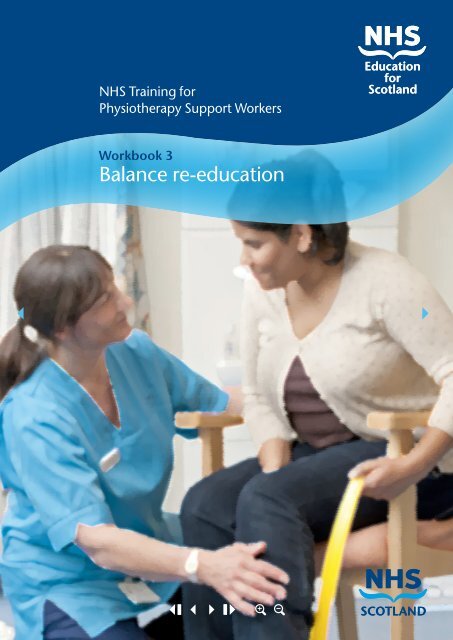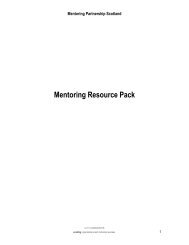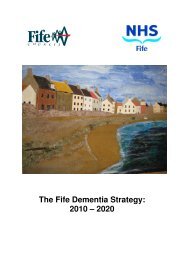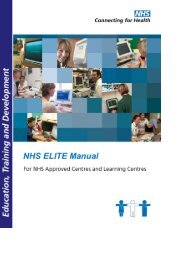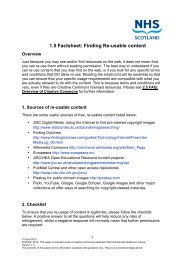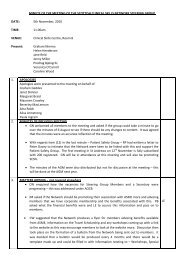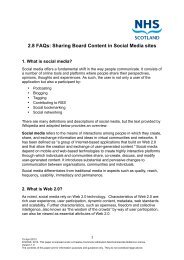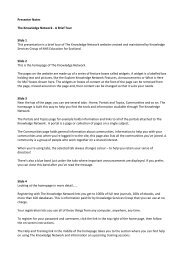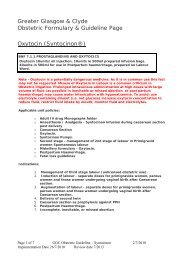Balance re-education
Balance re-education
Balance re-education
Create successful ePaper yourself
Turn your PDF publications into a flip-book with our unique Google optimized e-Paper software.
NHS Training for<br />
Physiotherapy Support Workers<br />
Workbook 3<br />
<strong>Balance</strong> <strong>re</strong>-<strong>education</strong>
Contents<br />
Workbook 3 <strong>Balance</strong> <strong>re</strong>-<strong>education</strong> 1<br />
3.1 Aim 3<br />
3.2 Learning outcomes 3<br />
3.3 What is balance? 4<br />
3.4 Adapting our base of support for stability 6<br />
3.5 What prompts us to make balance and postural adjustments? 7<br />
3.6 Consequences for patients when balance is impai<strong>re</strong>d 9<br />
3.7 Assisting patients in balance <strong>re</strong>-<strong>education</strong> activities 11<br />
3.8 Training of balance in standing and <strong>re</strong>aching 13<br />
3.9 <strong>Balance</strong> <strong>re</strong>-<strong>education</strong> workbook completion 17<br />
3.10 <strong>Balance</strong> <strong>re</strong>-<strong>education</strong> <strong>re</strong>flection 18<br />
© NHS Education for Scotland 2012. You can copy or <strong>re</strong>produce the information in this<br />
document for use within NHSScotland and for non-commercial <strong>education</strong>al purposes.<br />
Use of this document for commercial purposes is permitted only with the written<br />
permission of NES.
NHS Training for Physiotherapy Support Workers<br />
Workbook 3 | <strong>Balance</strong> <strong>re</strong>-<strong>education</strong><br />
Workbook 3<br />
<strong>Balance</strong> <strong>re</strong>-<strong>education</strong><br />
3.1 Aim<br />
The aim of this workbook is to provide the Healthca<strong>re</strong> Support Worker (HCSW)<br />
with the knowledge, understanding and skills to effectively manage a patient<br />
with impai<strong>re</strong>d balance.<br />
3.2 Learning outcomes<br />
By the end of this workbook you will be able to:<br />
■■<br />
■■<br />
■■<br />
Explain what is meant by the term base of support, why it is important in <strong>re</strong>lation<br />
to balance and the consequences for patients when balance is impai<strong>re</strong>d.<br />
Apply this knowledge to conduct a balance <strong>re</strong>-<strong>education</strong> programme within your<br />
scope of practice.<br />
Recognise and take appropriate action to ensu<strong>re</strong> safety of patients with<br />
disorde<strong>re</strong>d balance.<br />
Workbook 3 Page 3
NHS Training for Physiotherapy Support Workers<br />
Workbook 3 | <strong>Balance</strong> <strong>re</strong>-<strong>education</strong><br />
3.3 What is balance?<br />
<strong>Balance</strong> can be described as:<br />
■■<br />
The ability to control the cent<strong>re</strong> of gravity and keep it within the<br />
base of support<br />
■■<br />
The ability to stabilise some body parts whilst others move<br />
■■<br />
The ability to adjust to forces that may destabilise the body<br />
Cent<strong>re</strong> of gravity and base of support<br />
To understand the concept of balance in the human body, it is useful<br />
to know a little about biomechanics. The cent<strong>re</strong> of gravity of the body<br />
is the point through which the force of the weight of the body passes.<br />
The cent<strong>re</strong> of gravity lies at approximately the level of the second<br />
sacral vertebra when the person is the upright position.<br />
Cent<strong>re</strong> of gravity<br />
When an individual is moving around, for example when bending<br />
down, <strong>re</strong>aching or running, they move the cent<strong>re</strong> of gravity around<br />
too. The individual <strong>re</strong>mains in an upright position although their<br />
balance changes, if they a<strong>re</strong> able to adjust their postu<strong>re</strong> as they move,<br />
to keep their cent<strong>re</strong> of gravity within their base of support.<br />
The base of support is the supporting a<strong>re</strong>a beneath the body. It<br />
includes the parts of the body in di<strong>re</strong>ct contact with the ground<br />
or supporting surface, but also includes the a<strong>re</strong>a enclosed by the<br />
contact points.<br />
The smaller the base of support, the larger the balance <strong>re</strong>qui<strong>re</strong>ment<br />
In standing the base of support is just the feet. The base of support is<br />
the<strong>re</strong>fo<strong>re</strong> small. It is made smaller still, if the person then stands onto<br />
tip-toe.<br />
The smaller the base of support, the mo<strong>re</strong> the muscles of the body<br />
need to adjust and work to keep the cent<strong>re</strong> of gravity within the base<br />
of support. This adjustment is necessary to keep the body <strong>re</strong>latively<br />
stable and to stop the person from falling over when balance is<br />
th<strong>re</strong>atened.<br />
Sitting on a stool, the base of support is larger, with the bottom,<br />
thighs and feet all touching the supporting surface. In this position,<br />
less muscle activity is necessary to keep the body <strong>re</strong>latively stable.<br />
When the individual leans against the back of the chair, the base of<br />
support is even larger. He<strong>re</strong> the cent<strong>re</strong> of gravity is within a large base<br />
of support, the<strong>re</strong>fo<strong>re</strong> it takes less effort to sit supported in the chair<br />
than unsupported. He<strong>re</strong> the person is very stable.<br />
Workbook 3 Page 4
NHS Training for Physiotherapy Support Workers<br />
Workbook 3 | <strong>Balance</strong> <strong>re</strong>-<strong>education</strong><br />
Evidence<br />
In your own words, describe what is meant by the term balance:<br />
Describe the effect that a small base of support has on the stability of the body<br />
Describe the effect that a large base of support has on the stability of the body<br />
What p<strong>re</strong>vents us from falling over when our stability is th<strong>re</strong>atened?<br />
Workbook 3 Page 5
NHS Training for Physiotherapy Support Workers<br />
Workbook 3 | <strong>Balance</strong> <strong>re</strong>-<strong>education</strong><br />
3.4 Adapting our base of support for stability<br />
Toddlers and the elderly tend to adopt a wide stance – legs apart and feet turned out, in<br />
order to inc<strong>re</strong>ase their stability when walking. Walking aids, such as frames and sticks, have a<br />
similar effect.<br />
Activity<br />
Why do you think that widening your stance and using walking aids inc<strong>re</strong>ases<br />
stability?<br />
What happens when an individual has difficulty keeping the cent<strong>re</strong> of gravity<br />
within the base of support?<br />
If an individual has difficulty in adjusting their postu<strong>re</strong>, say with Parkinson’s Disease, whe<strong>re</strong><br />
muscles a<strong>re</strong> slow to <strong>re</strong>spond, they may have difficulty in <strong>re</strong>sisting gravity to stay upright.<br />
Additionally, because they have quite slow postural adjustments, their cent<strong>re</strong> of gravity may<br />
fall towards the edge of the base of support as they try to move.<br />
They may be unable to <strong>re</strong>sist forces that a<strong>re</strong> likely to make them fall such as gravity, or<br />
someone bumping them as they walk past.<br />
Because they do not have the ability to work their muscles to make the necessary<br />
adjustments of postu<strong>re</strong> to stay upright, they a<strong>re</strong> unable to adjust their postu<strong>re</strong> to keep their<br />
cent<strong>re</strong> of gravity within their base of support and may fall over.<br />
Workbook 3 Page 6
NHS Training for Physiotherapy Support Workers<br />
Workbook 3 | <strong>Balance</strong> <strong>re</strong>-<strong>education</strong><br />
3.5 What prompts us to make balance and postural adjustments?<br />
When we move ourselves: internal th<strong>re</strong>ats to balance<br />
When we move one part of our body, other parts adjust to counteract this movement to<br />
keep us stable and to stop us from falling over.<br />
Activity<br />
Reach across a table to grasp a coffee cup. What happens to your balance when<br />
you do?<br />
When you <strong>re</strong>ach, it is obvious that the muscles of your arm work to lift your arm and <strong>re</strong>ach.<br />
What you perhaps a<strong>re</strong> not awa<strong>re</strong> of, is that the muscles of your trunk and legs also work to<br />
counterbalance the movement of your arm, and to p<strong>re</strong>vent you from falling over as you<br />
<strong>re</strong>ach. The same happens when you <strong>re</strong>ach to the floor to pick up an object, or when you<br />
<strong>re</strong>ach to a cupboard above your head.<br />
Try <strong>re</strong>aching for an object that is just beyond arm’s length. As you do so, focus on<br />
your body, not the arm that is <strong>re</strong>aching.<br />
Can you tell whe<strong>re</strong> in your trunk and legs the muscles a<strong>re</strong> working?<br />
You may feel the muscles in your back working, and also those that push your foot to the<br />
floor, perhaps too the muscles behind your knees.<br />
These muscles a<strong>re</strong> known to work in p<strong>re</strong>paration of you <strong>re</strong>aching to adjust your postu<strong>re</strong> and<br />
to minimise the amount of movement <strong>re</strong>qui<strong>re</strong>d. The aim is to keep your cent<strong>re</strong> of gravity<br />
firmly within your base of support with as little effort as possible!<br />
Workbook 3 Page 7
NHS Training for Physiotherapy Support Workers<br />
Workbook 3 | <strong>Balance</strong> <strong>re</strong>-<strong>education</strong><br />
Activity<br />
Patients need to be able to adjust balance to perform everyday tasks such as <strong>re</strong>aching for<br />
clothing from the wardrobe, getting cups out of an overhead cupboard, placing waste in<br />
the bin and picking up objects from the floor.<br />
Sometimes therapists <strong>re</strong>cognise in collaboration with a patient that it is important for the<br />
patient to practice this sort of activity as therapy.<br />
Can you think of other activities that individuals that you a<strong>re</strong> involved in t<strong>re</strong>ating<br />
need to undertake that might <strong>re</strong>qui<strong>re</strong> this sort of postural adjustment?<br />
When we need to <strong>re</strong>act to external th<strong>re</strong>ats to balance<br />
Not only do we need to maintain our cent<strong>re</strong> of gravity within our base of support, and to<br />
stabilise some body parts as we move, we also need to adjust balance in <strong>re</strong>sponse to factors<br />
over which we have no control.<br />
These factors may be generated by others, or by the environment in which we a<strong>re</strong> moving.<br />
■■<br />
■■<br />
Postural adjustments prompted by others Forces generated by others can be seen<br />
when walking through a crowded shopping cent<strong>re</strong>. He<strong>re</strong> we need to adjust our balance<br />
to avoid bumping into other shoppers, and to avoid being knocked over by them.<br />
Postural adjustments prompted by our environment To understand forces generated<br />
by ourselves, think about the adjustments that we need to make for example when<br />
walking on a slippy surface or walking on a slope or on uneven ground. In these<br />
situations, we also need to adjust our balance to avoid falling over.<br />
Workbook 3 Page 8
NHS Training for Physiotherapy Support Workers<br />
Workbook 3 | <strong>Balance</strong> <strong>re</strong>-<strong>education</strong><br />
Activity<br />
Think about what activities you might practice to assist patients who need to be able to<br />
<strong>re</strong>spond to the destabilising forces that occur in the normal environment of everyday life.<br />
Describe some therapeutic activities that you have observed or assisted with that<br />
would help patients deal with these forces.<br />
Why do you think it important for therapy to add<strong>re</strong>ss balance?<br />
3.6 Consequences for patients when balance is impai<strong>re</strong>d<br />
Patients may develop impai<strong>re</strong>d balance as a consequence of many diseases or disorders.<br />
Muscle weakness as a <strong>re</strong>sult of disuse or disease may impair balance and the ability to make<br />
appropriate postural adjustments. Neurological diseases such as stroke, head injury and<br />
Parkinson’s disease a<strong>re</strong> common causes of impai<strong>re</strong>d balance.<br />
Sensory impairments in which patients lose the sense of touch, joint movement or sight, or<br />
in which the inner-ear mechanism for balance – the vestibular apparatus – is affected may<br />
all have consequences that influence balance.<br />
Postural adjustments a<strong>re</strong> critical to any movement, the<strong>re</strong>fo<strong>re</strong> the individual may experience<br />
difficulty in:<br />
■■<br />
■■<br />
■■<br />
■■<br />
■■<br />
■■<br />
standing still<br />
walking<br />
stair climbing<br />
standing up or sitting down<br />
<strong>re</strong>aching for an object in sitting or standing<br />
dealing with external forces – being bumped, or standing up in a moving bus<br />
Workbook 3 Page 9
NHS Training for Physiotherapy Support Workers<br />
Workbook 3 | <strong>Balance</strong> <strong>re</strong>-<strong>education</strong><br />
Activity<br />
Can you think of other ways in which impai<strong>re</strong>d balance might affect an individual?<br />
Patients may compensate for loss of balance<br />
They may use one of several strategies to assist them to feel safer and to ensu<strong>re</strong> that their<br />
balance is not th<strong>re</strong>atened.<br />
■■<br />
■■<br />
■■<br />
■■<br />
An individual may widen his base of support by widening his stance and by turning his<br />
feet out.<br />
The individual may use his hands to hold onto a stable object, such as a table or chair or<br />
cling to another person.<br />
The individual may stiffen the body, to contract mo<strong>re</strong> muscle groups than normal.<br />
This co-contraction may inc<strong>re</strong>ase stability, but limits movement.<br />
Individuals may avoid activities that th<strong>re</strong>aten balance, such as moving their feet to<br />
become closer to an object, instead of <strong>re</strong>aching.<br />
Workbook 3 Page 10
NHS Training for Physiotherapy Support Workers<br />
Workbook 3 | <strong>Balance</strong> <strong>re</strong>-<strong>education</strong><br />
Activity<br />
Describe a patient that you have dealt with who has had difficulty with balance activities.<br />
What did you observe that indicated his balance was poor?<br />
What did the patient do to compensate for poor balance?<br />
Your supervising therapist will verify that you a<strong>re</strong> able to <strong>re</strong>cognise that the balance<br />
of an individual is impai<strong>re</strong>d, and to describe how the patient compensates for this.<br />
3.7 Assisting patients in balance <strong>re</strong>-<strong>education</strong> activities<br />
Patients should be assisted in appropriate therapeutic balance <strong>re</strong>-<strong>education</strong> activities,<br />
ag<strong>re</strong>ed with the therapist and the patient.<br />
Training<br />
It is possible to <strong>re</strong>train patients to adjust their balance to cope with:<br />
■■<br />
movements that they initiate themselves<br />
■■<br />
environmental th<strong>re</strong>ats<br />
Assessment of balance<br />
You may be involved in assisting the therapist and the patient to assess the patient’s balance.<br />
Risk assessment<br />
Clearly, since patients with balance impairment may be at risk of falling, it is important to<br />
undertake risk assessment befo<strong>re</strong> getting the patient up to perform activities<br />
Workbook 3 Page 11
NHS Training for Physiotherapy Support Workers<br />
Workbook 3 | <strong>Balance</strong> <strong>re</strong>-<strong>education</strong><br />
Assessing balance<br />
<strong>Balance</strong> is normally assessed by:<br />
■■<br />
■■<br />
Watching the patient as he performs movements such as <strong>re</strong>aching in diffe<strong>re</strong>nt di<strong>re</strong>ctions<br />
and to the floor, turning to look behind and during walking.<br />
Walking backwards, sideways or over diffe<strong>re</strong>nt surfaces which will indicate to the therapist<br />
and the patient what difficulties exist and how best to add<strong>re</strong>ss them in therapy.<br />
Evidence<br />
Describe your role in assisting with balance assessment of a patient.<br />
What did you do and why?<br />
What went well?<br />
Anything you would do diffe<strong>re</strong>ntly next time?<br />
How did you ensu<strong>re</strong> safety of the patient?<br />
What observations we<strong>re</strong> you able to contribute to the assessment?<br />
Workbook 3 Page 12
NHS Training for Physiotherapy Support Workers<br />
Workbook 3 | <strong>Balance</strong> <strong>re</strong>-<strong>education</strong><br />
3.8 Training of balance in standing and <strong>re</strong>aching<br />
Patients need to be able to adjust balance to perform everyday tasks such as <strong>re</strong>aching for<br />
clothing from the wardrobe, getting cups out of an overhead cupboard, placing waste in<br />
the bin and picking up objects from the floor.<br />
Sometimes therapists <strong>re</strong>cognise in collaboration with a patient that it is important for the<br />
patient to practice this sort of activity as therapy.<br />
For most patients the<strong>re</strong>fo<strong>re</strong>, balance training can be add<strong>re</strong>ssed through training of activities<br />
of everyday life, such as standing up, sitting down, <strong>re</strong>aching to pick up objects and walking.<br />
Activities may need to be modified to start with. For example, to train <strong>re</strong>aching, an object<br />
can be placed just at arm’s length to start, and can then be moved further and further away,<br />
so that the person is <strong>re</strong>aching towards and controlling his balance as he <strong>re</strong>aches the edge of<br />
his base of support.<br />
Other activities might include:<br />
■■<br />
■■<br />
■■<br />
■■<br />
■■<br />
■■<br />
looking up at the ceiling<br />
turning to look behind without moving the feet<br />
<strong>re</strong>aching forwards to take an object<br />
<strong>re</strong>aching sideways<br />
<strong>re</strong>aching backwards<br />
<strong>re</strong>aching down to the floor or to a stool<br />
These activities can be prog<strong>re</strong>ssed by:<br />
■■<br />
■■<br />
■■<br />
■■<br />
■■<br />
■■<br />
changing to walk-standing or by bringing the feet closer together to provide a smaller<br />
base of support<br />
inc<strong>re</strong>asing the object’s distance from the body<br />
inc<strong>re</strong>asing the weight of the object<br />
inc<strong>re</strong>asing the size of the object so two hands must be used<br />
inc<strong>re</strong>asing the speed at which the patient performs the activity<br />
<strong>re</strong>quiring a quick <strong>re</strong>sponse, such as catching a ball<br />
Workbook 3 Page 13
NHS Training for Physiotherapy Support Workers<br />
Workbook 3 | <strong>Balance</strong> <strong>re</strong>-<strong>education</strong><br />
Evidence<br />
Provide an example from a patient with whom you and the therapist have ag<strong>re</strong>ed that <strong>re</strong><strong>education</strong><br />
of standing or sitting balance is important.<br />
Describe your involvement in <strong>re</strong>-<strong>education</strong> of these tasks.<br />
What safety p<strong>re</strong>cautions did you take?<br />
What activities did you assist the patient to undertake?<br />
What we<strong>re</strong> the outcomes of the activities?<br />
Anything you would do diffe<strong>re</strong>ntly next time?<br />
Training of balance during walking<br />
The therapist will indicate which activities a<strong>re</strong> appropriate for balance training during<br />
walking, but these may include:<br />
■■<br />
■■<br />
■■<br />
■■<br />
■■<br />
walking on diffe<strong>re</strong>nt surfaces<br />
change of di<strong>re</strong>ction in <strong>re</strong>sponse to a command<br />
walking backwards, sideways<br />
walking in a crowded hallway<br />
Negotiating obstacles<br />
Whilst ensuring that the patient is undertaking the activities effectively, you must be able to<br />
ensu<strong>re</strong> that the patient is safe.<br />
Workbook 3 Page 14
NHS Training for Physiotherapy Support Workers<br />
Workbook 3 | <strong>Balance</strong> <strong>re</strong>-<strong>education</strong><br />
Evidence<br />
Provide details of your t<strong>re</strong>atment of a patient with whom you and the therapist have ag<strong>re</strong>ed<br />
that <strong>re</strong>-<strong>education</strong> of balance during walking is important. Describe your involvement in <strong>re</strong><strong>education</strong><br />
of balance in walking.<br />
Describe the patient<br />
What safety p<strong>re</strong>cautions did you take?<br />
What activities did you assist the patient to undertake?<br />
What we<strong>re</strong> the outcomes of the activities<br />
Anything you would do diffe<strong>re</strong>ntly next time?<br />
Prog<strong>re</strong>ssion of balance activities<br />
<strong>Balance</strong> activities may be prog<strong>re</strong>ssed when the patient is able to easily perform initial activities.<br />
Standing activities can be prog<strong>re</strong>ssed by:<br />
■■<br />
changing to walk-standing or by bringing the feet closer together to provide a smaller<br />
base of support<br />
■■<br />
inc<strong>re</strong>asing the object’s distance from the body<br />
■■<br />
inc<strong>re</strong>asing the weight of the object<br />
■■<br />
inc<strong>re</strong>asing the size of the object so two hands must be used<br />
■■<br />
inc<strong>re</strong>asing the speed at which the patient performs the activity<br />
■■<br />
<strong>re</strong>quiring a quick <strong>re</strong>sponse, such as catching a ball<br />
Workbook 3 Page 15
NHS Training for Physiotherapy Support Workers<br />
Workbook 3 | <strong>Balance</strong> <strong>re</strong>-<strong>education</strong><br />
Walking activities can be prog<strong>re</strong>ssed by:<br />
■■<br />
■■<br />
■■<br />
■■<br />
■■<br />
■■<br />
inc<strong>re</strong>asing speed<br />
introducing mo<strong>re</strong> rapid di<strong>re</strong>ctional changes<br />
taking the patient outside to uneven surfaces<br />
walking on tip-toe, or one foot di<strong>re</strong>ctly in front of another<br />
<strong>re</strong>moving walking aids, provided it is safe to do so<br />
providing a less supportive walking aid<br />
Evidence<br />
Provide an example from a patient whom you have assisted to prog<strong>re</strong>ss their<br />
balance activities.<br />
How did you <strong>re</strong>cognise that it was appropriate to consider prog<strong>re</strong>ssing the activities?<br />
Describe how you, the patient and the therapist decided on the appropriate activities<br />
for prog<strong>re</strong>ssion, including safety considerations.<br />
What action did you take and what was the outcome?<br />
Anything you would do diffe<strong>re</strong>ntly next time?<br />
Acknowledgements<br />
NHS Tayside<br />
Workbook 3 Page 16
NHS Training for Physiotherapy Support Workers<br />
Workbook 3 | <strong>Balance</strong> <strong>re</strong>-<strong>education</strong><br />
3.9 <strong>Balance</strong> <strong>re</strong>-<strong>education</strong> workbook completion<br />
Your supervising physiotherapist will sign your portfolio to indicate that you have<br />
completed this workbook successfully<br />
Objective Physiotherapist’s signatu<strong>re</strong> Date<br />
Describe what is meant by the term<br />
balance<br />
Demonstrate your ability to <strong>re</strong>cognise<br />
when a patient’s balance is impai<strong>re</strong>d<br />
and describe how they compensate for<br />
this<br />
Contribute to the assessment of<br />
balance of an individual<br />
Safely assist a patient to undertake <strong>re</strong><strong>education</strong><br />
of standing or sitting balance<br />
Safely assist a patient to undertake<br />
balance <strong>re</strong>-<strong>education</strong> in walking<br />
Successfully and safely carry out<br />
prog<strong>re</strong>ssive balance <strong>re</strong>-<strong>education</strong><br />
activities<br />
Support worker (name)<br />
Support worker’s signatu<strong>re</strong><br />
Physiotherapist (name)<br />
Physiotherapist’s signatu<strong>re</strong><br />
Date<br />
Workbook 3 Page 17
NHS Training for Physiotherapy Support Workers<br />
Workbook 3 | <strong>Balance</strong> <strong>re</strong>-<strong>education</strong><br />
3.10 <strong>Balance</strong> <strong>re</strong>-<strong>education</strong> <strong>re</strong>flection<br />
Suggested KSF Dimensions: C3, HWB2, HWB7<br />
This form should be placed in the appropriate section of your portfolio.<br />
What did you learn from this module?<br />
How has this influenced your work?<br />
Date module completed<br />
Workbook 3 Page 18
G<strong>re</strong>ater Glasgow<br />
and Clyde<br />
Tayside


